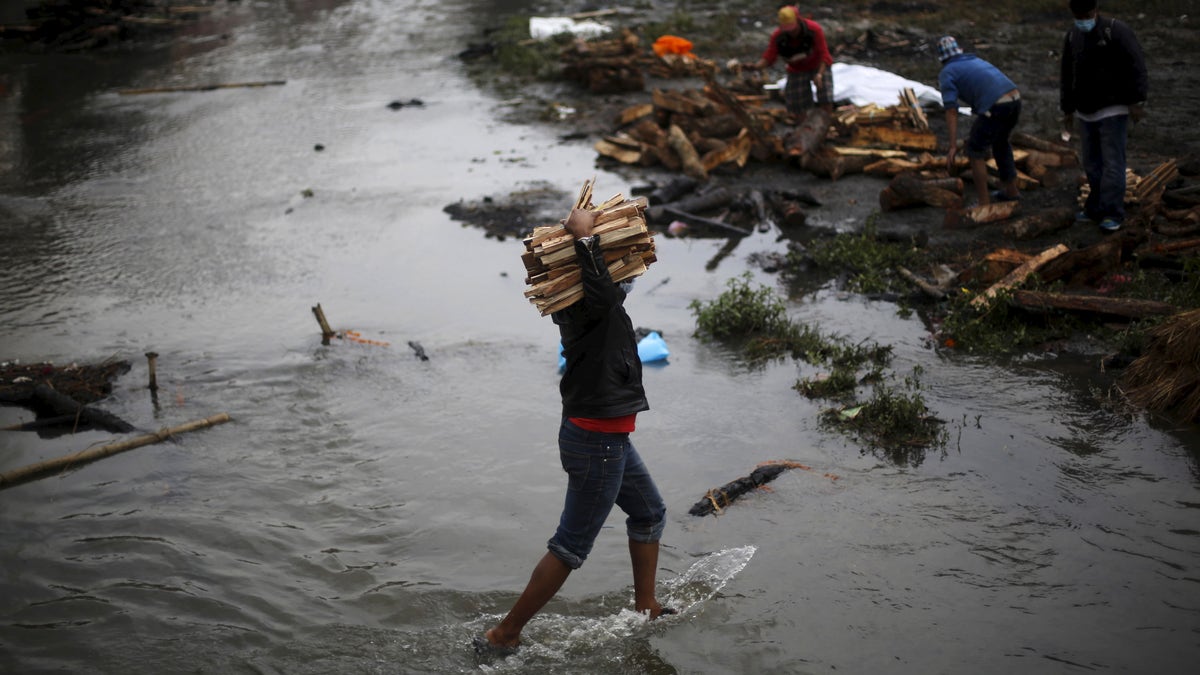
A man carries wood for pyre to burn the bodies of victims of Saturday's earthquake, during the cremation along a river in Kathmandu, Nepal April 28, 2015. REUTERS/Adnan Abidi - RTX1AOND
The aftermath of the Nepal earthquake brings a risk of disease outbreaks — including measles and diarrheal diseases — among the survivors, and humanitarian agencies are rushing to bring aid to help.
The 7.8-magnitude earthquake that hit the region Saturday (April 25) has had a devastating impact, with an estimated 7 million people affected, including 2.8 million children, according to the United Nations Children's Fund (UNICEF). As many as 1.5 million people in the Kathmandu Valley are now spending their nights outdoors, either because their homes have been destroyed or they are afraid to spend the night in their homes, said Christopher Tidey, a UNICEF spokesman.
Such a large congregation of people living out in the open can increase not only the risk of diseases spreading, but also the speed at which they spread, Tidey said.
"If you have people living in very close proximity to each other…then diseases can spread much faster," Tidey told Live Science. Diarrheal and respiratory diseases are some of health experts' main concerns in the earthquake's aftermath. "You're more at risk for something like a measles outbreak," under these conditions, Tidey said.
One of the first actions that disaster-response teams will take is to provide safe drinking water by setting up a sanitation system, said Dr. David Milzman, a professor of emergency medicine at Georgetown University School of Medicine. "Even more than food, you need clean water," Milzman said.
UNICEF is helping to pay for water tanks in areas where people are congregating, Tidey said. [Top 10 Deadliest Natural Disasters in History]
The organization is also providing people with oral rehydration salts and zinc supplements to help prevent diarrheal diseases. The rehydration salts are added to water and provide electrolytes to help people hydrate, Tidey said. The zinc supplements help with immune function and the transport of water in the body, according to the World Health Organization.
And because there may be damage to the Nepal's health infrastructure, including the equipment needed to keep vaccines at the right temperature, UNICEF is working to make sure the country's vaccines are stored properly, and assessing the population to see if people may need to be vaccinated to prevent measles spread, Tidey said.
One challenge after disasters like the Nepal earthquake is just providing people with the care they would normally need in their daily lives.
"Every day, people get ill and get sick," Milzman said. But now, after the earthquake "it will be difficult just to continue business as usual," Milzman said. For example, people who need dialysis or daily medications may not be able to access them.
"You're going to have a lot of secondary spikes in illness, because people reliant on medical care can't get it," Milzman said.
Still, several organizations are working to provide survivors with essential items and medical supplies. The Red Cross says it has 19,000 relief kits, which contain clothing, kitchen sets, personal hygiene items and more, available in Nepal. And the World Health Organization has distributed medical supplies that can meet the needs of 40,000 people for three months, the agency said Sunday (April 26).
Disasters can also make it harder for women to breast-feed their infants, Tidey said. UNICEF will be working with partners to provide places for women to breast-feed, such as special tents, Tidey said.
Another big challenge for the humanitarian relief effort will be getting access to remote areas in Nepal, which are difficult to reach because of the lack of transportation infrastructure, Tidey said.
"We know that they've sustained quite a bit of damage, but so far it hasn't been easy to get out to some of these places," Tidey said. Some remote villages still have not received assistance, two days after the earthquake, according to the New York Times.
Although the 2010 Haiti earthquake presented challenges, the Nepal earthquake is in some ways more challenging because of its remote location, said Milzman, who was involved with the Haiti response. The relief effort from the United States will be slower because of the greater distance between the two countries, he said.
- 7 Devastating Infectious Diseases
- The 10 Biggest Earthquakes in History
- 5 Viruses That Are Scarier Than Ebola
Copyright 2015 LiveScience, a Purch company. All rights reserved. This material may not be published, broadcast, rewritten or redistributed.
